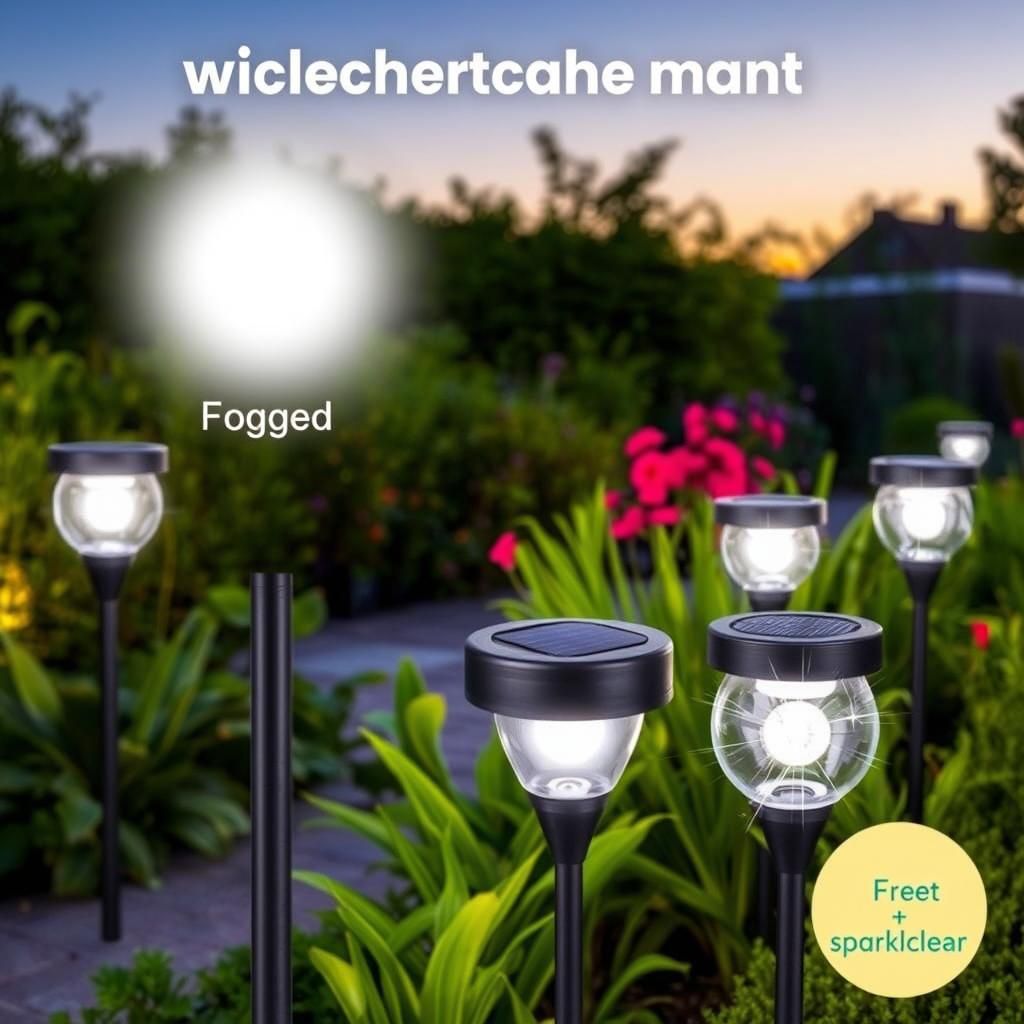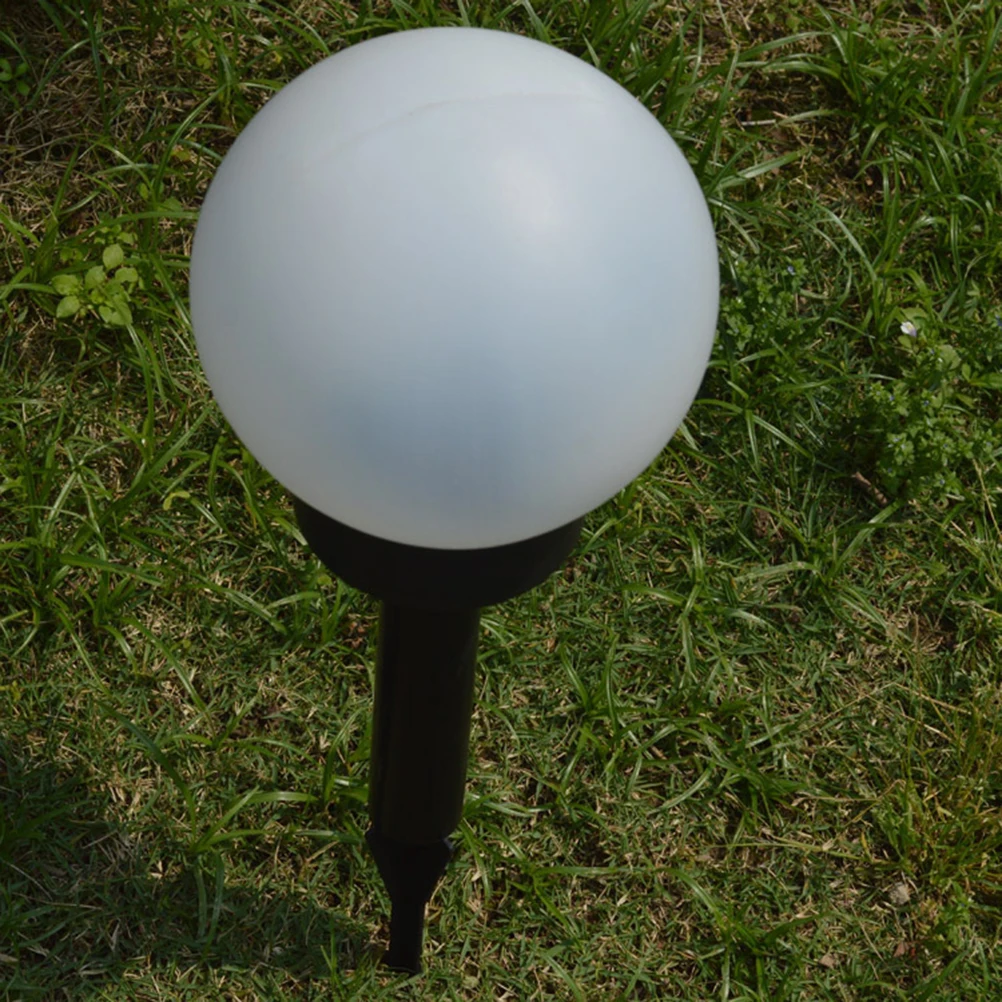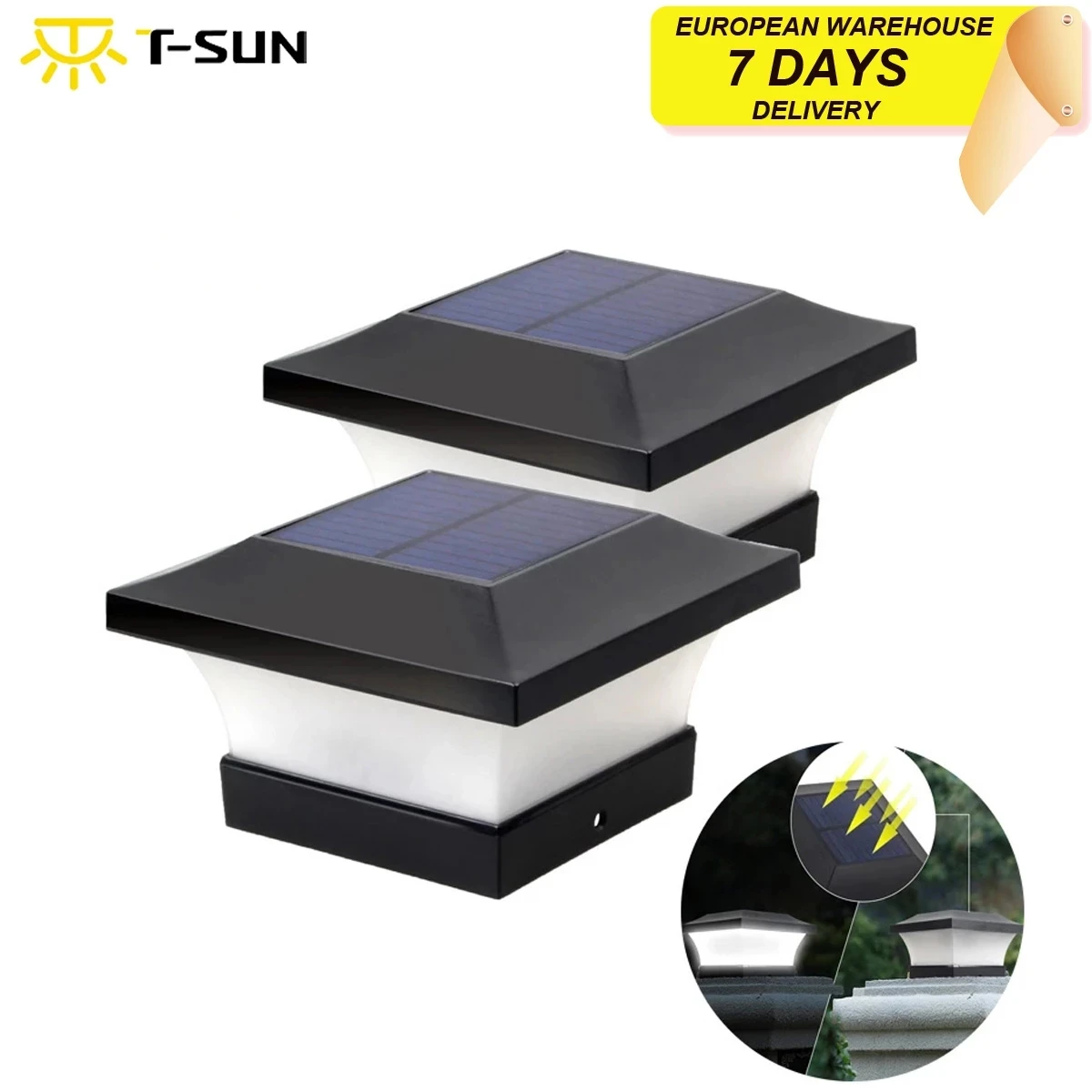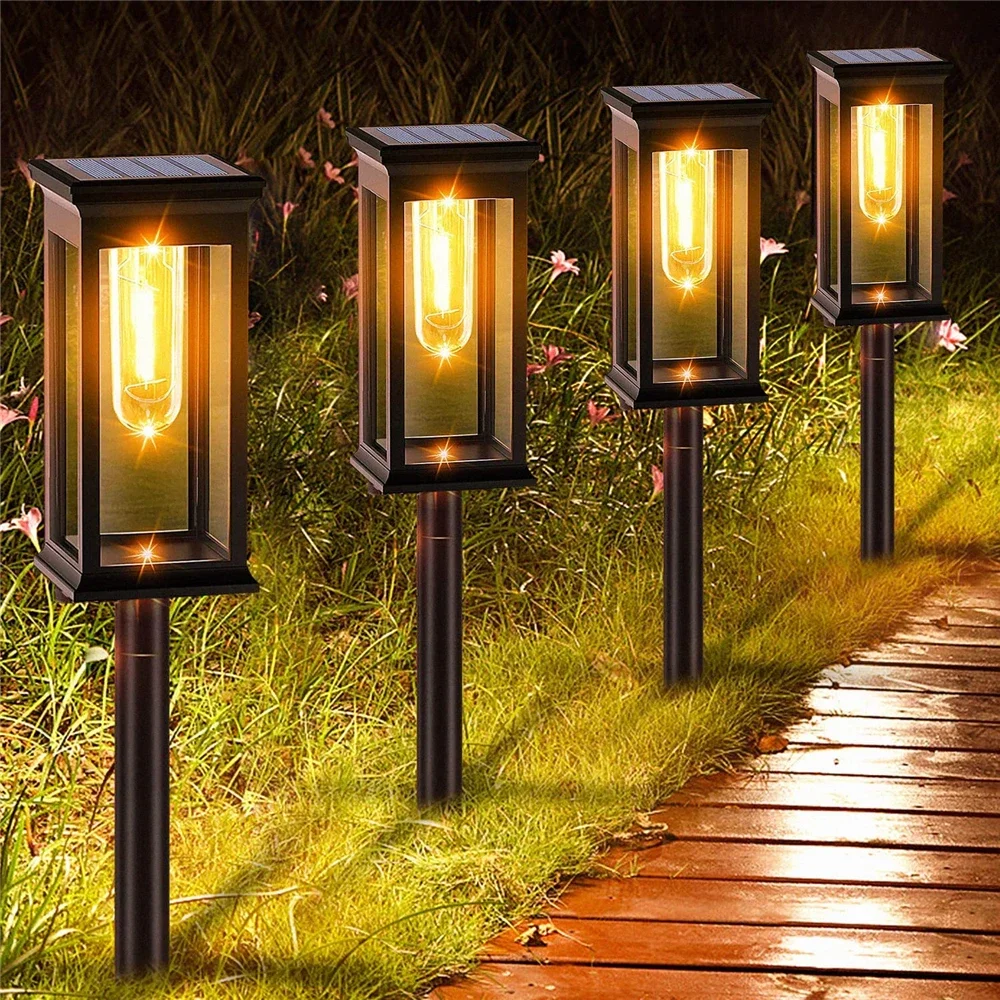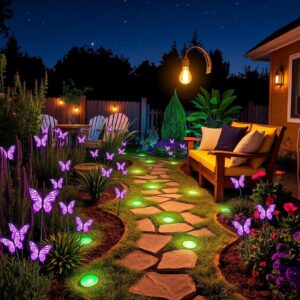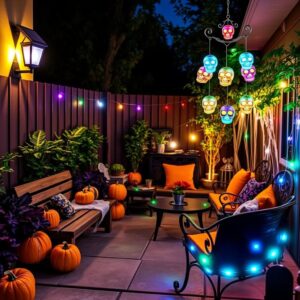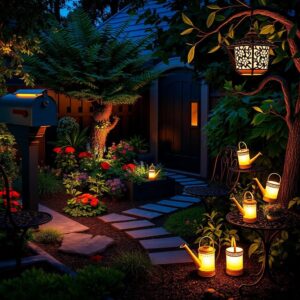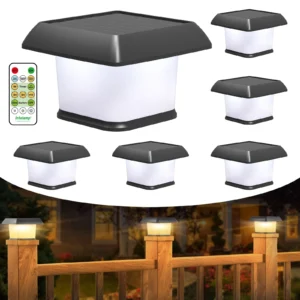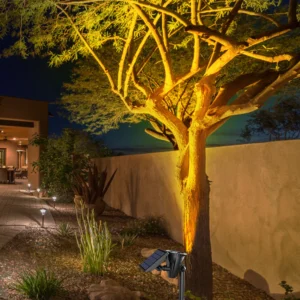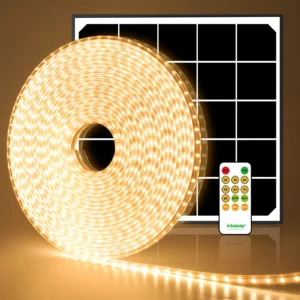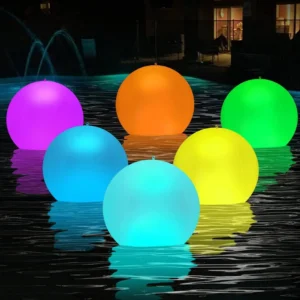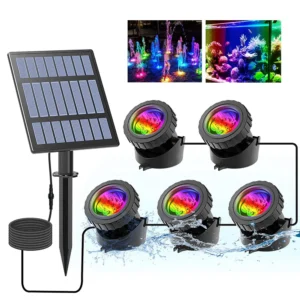Solar Lanterns LED Outdoor Garden Yard Decoration
1. Understanding Why Solar Lights Fog Up
Let’s keep it simple and straightforward: you put solar lights in your garden to enjoy soft, sustainable glows—but sometimes those lenses go cloudy, and the magic fades. Why does this happen? Most often, fogging comes down to some basic physics, steady old sunlight, and the moods of your local weather. If you’ve found yourself staring at misted-over solar lanterns and wondering what gives, you’re not alone. Let’s break it down.
The Role of Condensation
Condensation is public enemy number one for solar light clarity. At heart, most solar lights are just small plastic containers, exposed to everything the sky throws at them. During warm days, the air inside your solar light expands. As the sun dips and temperatures slide, that air cools, contracts, and leaves behind moisture—tiny water droplets—on the inside of the lens. This is the same trick your bathroom mirror plays after a hot shower, just miniaturized.
Now, it doesn’t take a torrential downpour to get moisture in your solar lights. Humid climates speed it up, but even those cool, dry, crystal-clear nights can cause condensation to appear if daytime temps were high. Quick shifts—think day-night temperature swings—are the perfect recipe for fog. Not surprisingly, if your solar light isn’t perfectly sealed, even more air can sneak in and create a repeat cycle every evening.
In short: condensation is unavoidable sometimes. The outdoors changes constantly, and water vapor is just waiting to cling to your light’s lens. It’s normal, but it’s also manageable once you know what you’re dealing with. Read more on condensation causes.
Aging and Material Degradation
Let’s talk about the toll time takes. Even if condensation wasn’t a factor, solar light covers aren’t invincible. The vast majority are made from plastic, which spends every day under the watchful gaze of the sun’s UV rays. Over months and years, ultraviolet light slowly breaks down those clear plastics, causing them to discolor and lose that crystal clarity. The result? A permanent, cloudy haze that won’t scrub away.
And it’s not just the sun. All those little scratches from dust, dirt, or even your hands cleaning them, chip away at the surface, giving more places for fogginess and dirt to settle in. This isn’t a product flaw so much as an expected outcome. Think of it like your favorite sunglasses eventually getting scratched or faded after a season of hard use—solar lights are the same deal.
There’s a fine line, though. Some fogging is natural and comes from wear and tear. But if your lights go hazy straight out of the box or after just a few weeks—then you might have a manufacturing issue on your hands. It pays to buy quality and, if possible, look for lights that advertise UV-resistant lenses.
Environmental Factors
The final piece of the puzzle? Where and how you use your solar lights matters—a lot. If they’re tucked under thick tree canopies, nestled near damp garden beds, or placed somewhere the morning dew clings like a second skin, you’ll see more fog. Shady, moist environments slow down evaporation and encourage condensation to stick around longer.
Seasonal weather patterns affect things, too. Think about winter, where cold nights and weak sun create a cycle of freezing and thawing. Or stormy summers, where humidity spikes. Any time the garden’s environment flips between warm and cool, dry and wet, condensation is more likely to sneak inside and linger.
Even the design of the light itself is a player. Some are engineered with better seals, clearer airflow, or drainage to help keep moisture out—or at least moving. Simpler models tend to have more gaps or less protection, becoming little fog magnets after just a single season.
When you piece it all together, foggy solar lights are a result of basic outdoor living, the relentless beating of sun and weather, and the materials their covers are made from. Understanding why it happens puts the power back in your hands—because once you know how sunlight, water vapor, and time conspire against your garden lights, you’re halfway to making sure that magical evening glow comes back, night after night.
Flat Solar Puck Lights for Outdoor Garden Pathway Lighting
2. Common Causes of Cloudy or Foggy Solar Lights
If you’ve ever walked your yard at dusk only to find your once-sparkling solar lights looking dull, milky, or straight-up foggy, you’re in good company. This is a classic garden gripe—cloudy solar light lenses are a fact of outdoor life, and the culprits tend to fall into a few everyday buckets: condensation, UV wear and tear, and the slow invasion of dirt and debris.
Condensation and Poor Sealing
Let’s start with the kingpin: condensation, teamed up with lackluster sealing. True, your solar lights are built to stand up to the elements, but the truth is, most don’t have a flawless seal. A bit of rain, a splash from the sprinklers, a humid night—moisture finds its way inside, especially if there are even tiny gaps around the lens or housing. Once inside, that water vapor does what it always does: condenses when the temperature drops, fogging up the inside of your lens.
Seal quality really makes or breaks things. Sometimes, it’s a manufacturing issue—maybe the light never quite snapped together cleanly. In other cases, exposure to sun and temperature swings loosens or warps the plastic, slowly widening those invisible gaps. The result? Regular, sneaky moisture intrusion that leaves the lens misty or spotty, night after night.
This isn’t always catastrophic at first—some lights fog up a little each morning and clear by noon. But enough cycles, plus a persistent leak, and your lens goes from slightly hazy to full-on frosted, permanently.
UV Damage and Oxidation
Sunshine is what powers your garden glow, but it’s also the silent troublemaker behind cloudy solar lights. The plastic covers that protect the solar panel and bulb face direct sunlight daily. Over time, those ultraviolet (UV) rays do what they do best: break things down at a molecular level.
Here’s the science, in plain English. UV light triggers slow but steady photodegradation in most plastics, causing them to develop a yellowish tint or take on a permanently cloudy appearance. This is the same process that fades patio furniture or brittle garden hoses—it’s all about plastic aging under constant sun exposure, called oxidation. You won’t notice it right away, but check a year-old solar light side-by-side with a new one—there’s no comparison.
Some brands now use UV-resistant plastics to fight this, but cheaper models skip the upgrade. Oxidation is more than just looks; it roughens the surface and actually makes it easier for dirt and water to latch onto the lens, making the cloudiness worse.
Accumulation of Dirt and Debris
Last but not least, there’s plain old grime. Gardens are dusty places. Winds whip up pollen and soil, leaves fall, bugs collect under the glow. Over weeks and months, even lights in the “clean” part of your yard get buried under an invisible film of dirt. Mix in a few rain showers and that dust sticks to the lens like glue.
If you’re not in the habit of giving your solar lights a rinse—who is, really?—that build-up just keeps compounding. Grime mixed with a little moisture can form a paste that resists rain or morning dew. Add scratches from occasional brushes with pets, lawnmowers, or even your own attempts to wipe them clear, and the surface gets pitted and foggy, creating a dull haze that regular sunlight can’t cut through.
Occasionally, internal parts can add to the mess too. If the seal is bad, dirt may sneak inside, muddying up the lens from both sides and making wiping the outside almost pointless.
Cloudy solar lights almost never have a single cause. Usually, it’s a bit of poor seal here, a little UV wear there, and a steady buildup of dirt everywhere. Think of it as a combination lock—get any two or three numbers lining up, and suddenly your lights look like they’re peering through a steamy shower door. The upside? Most causes are fixable—or at least manageable—so you don’t have to accept fuzzy path lighting as your garden’s fate. Stay curious, keep an eye out for these common culprits, and you’ll be well on your way to reclaiming that twinkling backyard glow.
Solar Mailbox Light – Elegant Solar Fixture with Automatic Control
3. How to Clean and Restore Fogged Solar Light Covers
If you’re rolling your eyes at yet another solar light going from sparkling clear to hazy and dull, know you’re not alone. Fogged-up lenses are almost a rite of passage for anyone who’s let the sun take care of their garden mood lighting. But here’s a little good news: With a bit of elbow grease—and maybe a dash of DIY spirit—you can restore those lights and get them gleaming again.
Standard Cleaning Methods
Before you reach for anything fancy, remember that simple often works best. Your solar light covers are just plastic (sometimes glass), and they live outside—collecting dust, pollen, water spots, and the occasional smudge of bird droppings. The first step is basic cleaning:
1. Remove the cover if possible. Most lights have a snap-off or twist-off lens. Be gentle; old plastic can be brittle.
2. Wash with warm soapy water. Drop your cover into a basin with mild dish soap and warm water. Let it soak for a minute, then scrub with a soft cloth or a non-scratch sponge. Forget steel wool or those aggressive scrubbers—they’ll leave permanent marks.
3. Gentle abrasives, if needed. If you’re staring down years of grime or that telltale ‘milky’ haze, a small dab of toothpaste on a cloth can act as a gentle abrasive. Rub in circles, rinse, and inspect. For persistent cloudiness, a baking soda paste (baking soda plus a splash of water) is another safe bet—just be sure to rub gently and rinse thoroughly.
4. Dry completely. Water spots and leftover moisture are the enemy, so let the lens air-dry, or wipe it down with a microfiber cloth. If you reassemble while the plastic’s still damp inside, you’re just setting yourself up for more condensation.
Regular cleaning—every few months if you can swing it—does wonders. Not only do your lights look better, but the solar panel often thanks you too, soaking in more power when it’s clean. For a deeper step-by-step how-to, check out these Wikihow solar light cleaning instructions.
Trending Cleaning Hacks
Now, if you’ve cleaned, scrubbed, and wiped—and you’re still seeing that stubborn haze—it’s time to try a few hacks that have caught fire in DIY circles. Two popular fixes? WD-40 and clear nail polish. Here’s how they work and when to try them.
WD-40 Restoration Hack:
Spray a small amount of WD-40 onto a soft cloth and buff the cloudy plastic lens. WD-40 leaves a temporary film that fills in microscopic scratches and gives a clearer appearance. Don’t soak the plastic—just a light polish. The effect isn’t permanent, but it can get you through the season. Just know: repeated use can gunk up your lens, so don’t overdo it.
Clear Nail Polish Trick:
For the truly persistent patches, a thin coat of clear nail polish can help revive clarity. Apply a light, even coat over the cleaned and dried lens. This trick works by creating a new, ultra-thin protective layer that covers up micro-scratches and ‘mists’ on old plastic. Be careful, as too much polish can goop up or create brush marks.
Both methods have roots in the car and craft world, but plenty of gardeners swear by them. You don’t have to take their word for it—here are some recent cleaning trends showing how folks are bringing life back to their lights with these simple fixes.
A Few Words of Caution
A hack is only as good as its side effects. Never use harsh solvents or abrasives (think acetone, paint thinner, or hard scouring pads) if you don’t want to end up with a foggier, scratched-up mess than you started with. And don’t forget to let everything dry fully before popping the lens back in place—it’s the easiest way to dodge an instant return of the fog.
Don’t Let the Fog Win
With a little maintenance, a splash of soapy water, and the occasional creative fix, you can keep your solar lights shining clear all season. Sure, you might need to touch up every few months—outdoor life is tough, after all—but that’s a small tradeoff for a welcoming, well-lit garden. Stay consistent, don’t be afraid to try a hack or two, and your solar path will stay as bright as your evenings deserve.
Resin Elf Reading Solar Lights for Garden Patio Decoration
4. Preventing Solar Light Fogging
Let’s be real—no one wants to greet dusk with a garden full of dim, foggy solar lights. Luckily, keeping those housings clear isn’t impossible. A little routine care and a few smart tweaks can go a long way toward holding the haze at bay. Here’s what works, why it matters, and how you can give yourself the best shot at garden lights that shine bright all year.
Maintenance Practices
As with most things outdoors, prevention hinges on consistency—and a dash of common sense. The simplest (and most often skipped) move? Regular cleaning. Schedule a quick rinse and wipe-down of your solar light covers once every couple of months or after periods of heavy weather. It doesn’t have to be fancy. Warm soapy water, a soft cloth, maybe a little baking soda paste for tougher spots—see the earlier section for the nitty-gritty. This habit clears off grime and microscopic debris that help condensation cling to the surface. Every cleaning buys your lights a little more brilliance and a lot less fog.
Placement deserves a mention. Think before you stick those stakes in the soil. Look for locations that aren’t prone to pooling water, are less shady, and have decent airflow. Avoid nestling solar lights directly under dense shrubs or in damp, low-lying beds—these spots turn into moisture magnets, feeding the fog cycle. Let your lights bask in the sun, catch a breeze, and dry out quickly after a rain. If you look across your yard and see sunlight patchwork, aim for the driest spots with plenty of air.
Long-Term Preventive Measures
If you want to go the extra mile, there are a couple of smart, low-effort tricks that fight fog for the long haul.
First up: silica gel packs. You know those little packets that ship with shoes or beef jerky? They work wonders at sucking up stray moisture. Place a couple inside the main housing of your solar lights (away from wiring or moving parts). The silica absorbs excess humidity before it ever condenses—cutting off fog at the source. Just remember, you’ll want to swap them out every few months because they fill up with moisture over time.
Next, focus on the integrity of your lights themselves. Over years, seals break down. Gaps form. If you’re buying new lights, look for models that advertise weatherproofing and double gaskets or O-rings. If you’re working with what you have, check the fit around the lens—the fewer wobbles or gaps, the better. A quick bead of outdoor-rated silicone sealant (the clear kind found at any hardware store) can close up small gaps around the housing. Just don’t block any drainage holes—your lights need to shed water, not trap it.
Here’s a handy guide on sealing and prevention if you want a more detailed walkthrough.
Upgrading Materials
Fogging isn’t always just a maintenance lapse—it can be a materials problem too. A lot of solar lights use cheap, basic plastics that degrade under UV light, getting brittle and cloudy way sooner than you’d like. If you’re planning an upgrade (or even just replacing a few lights at a time), keep an eye out for models with UV-resistant plastics. These are built to withstand years of direct sunlight and resist that fog-inducing breakdown. They won’t be immune to all forms of condensation, but they’ll hold their sparkle longer and make regular cleaning much easier.
Also, pay attention to the finish—smoother, shinier surfaces tend to repel water and dirt, giving condensation fewer places to hide.
The bottom line? Preventing solar light fogging isn’t rocket science—it’s maintenance, smart placement, and a willingness to spend a little extra on lights that are built to last. Regular cleaning stops the small stuff. Silica packs and good seals block the big stuff. And chasing UV-resistant plastics hedges your bets for the future. Take a practical, hands-on approach, and your solar garden will keep shining clear, lighting up your evenings the way you always pictured.
Warm White Solar Pathway Lights – Waterproof Garden Lighting
5. Does Fogging Affect Solar Light Performance?
Let’s get right to it: a little cloudiness on your solar lights probably isn’t the end of your backyard ambiance. But as anyone who’s watched a pristine path light turn dull and faint knows, fogging isn’t just about appearances—it can mess with function too. Here are the hard facts about what a fogged-up lens actually means for your solar setup.
Short-Term Effects
Early on, solar light fogging is mostly cosmetic. If you pop outside and notice a bit of mist or patchy haze on the lens, chances are your lights will still shine more or less as expected. The beam might look a tad softer or more diffused—a little less like a crisp circle and a little more like a soft glow. For garden use, pathway lighting, or accenting a flowerbed, this isn’t always a bad thing. In fact, some people like a subtle, candlelit effect. If your lights are new, and you’re only spotting morning condensation that burns off by noon, you can usually ignore it.
The other upside: initial fogging doesn’t zap battery life right away. If the rest of the fixture is clean, the solar panel should still catch plenty of sun, and the LEDs inside won’t have to work any harder than usual. Your evening “wow” factor may dial back a notch, but you’re not losing hours of light just because things look a little foggy.
Long-Term Buildup Consequences
It’s a different story if left unchecked. Persistent and heavy fogging, especially the kind that doesn’t go away after the sun’s been up for hours, signals a bigger issue. As that cloudy layer builds, it can actually reduce the amount of sunlight that makes its way to both the solar panel and the bulbs beneath the lens.
Over time, this sets off a chain reaction. Less sunlight collected during the day means your battery doesn’t charge up fully. Not enough charge means your lights don’t stay on as long—or they run dim hours before midnight hits. Eventually, the glow you loved turns weak and spotty. That “enchanted garden” look fades fast.
Heavy fogging also scatters light, cutting down the illumination radius. If you’re counting on solar path lights for safety or to let guests find their way, a heavy haze could turn useful spots of light into damp, underwhelming blurs. Read up on long-term fogging impacts here.
As for what to do next, you’ll want to assess: is the fog simply a bit of condensation you can clean, or is it baked deep into the lens from sun damage and age? If it wipes away or lifts after cleaning, you’re back in business. If it sticks, replacement might be the smarter play.
Signs of Normal Wear vs. Faulty Product
Not every case of fogged lights means something went wrong during manufacturing. UV damage, condensation, and grime are all normal parts of a solar light’s outdoor lifecycle. Most fogging, especially when it develops after months or a season of use, means your light is just aging in place—no defect necessary. Cheaper plastics will show this wear sooner, while higher-end versions with UV-resistant covers stave it off longer, but nothing is truly immune to Mother Nature.
If, however, you run into clouding within a few weeks of purchase, or your light comes out of the box foggy, that’s another story. Early, persistent fogging or clear moisture trapped inside a supposedly sealed unit could point to a faulty seal, poor assembly, or subpar materials. Don’t hesitate to reach out for a warranty swap or refund if you suspect something’s off. Here’s what others say about normal wear and product quality.
Bottom Line
In the end, the effect of fogging is a slow fade rather than a hard stop. A touch of haze here and there is part of the game—but let build-up linger, and you’ll gradually lose both light and battery punch. Treat fogging as your early warning sign: maintain where you can, upgrade when you need to, and don’t sweat a little character on well-loved lights. As long as you’re vigilant, your solar garden can stay bright, reliable, and full of evening charm.
Copper Solar Light Wind Chime with LED Glow and Wind Chime Tubes
6. Latest Industry Trends and Common Myths
Take a look at any patio this season and you’ll spot plenty of solar lights—torches lined along walkways, lanterns tucked under eaves, and modern cubes sprinkled throughout lawns. Every year, more homeowners jump on the solar wagon, and the lights themselves just keep evolving. So, what’s changing behind the scenes? And what persistent myths should you stop worrying about? Let’s cut through the fog.
2025 Trends in Solar Light Manufacturing
The next generation of solar lights isn’t your grandpa’s plastic path marker. Manufacturers know the industry’s biggest headache is lens clouding, so there’s a lot happening to keep lights clearer, longer. For 2025, the focus is on two fronts: better materials and smarter engineering.
First, UV-resistant plastics are getting a big upgrade. The technology isn’t just a marketing buzzword—new formulations are designed to fend off that slow, yellowing breakdown older plastics can’t avoid. These polymers shrug off years of sun exposure, staying clear and holding their shape well past what budget-tier lights deliver. Some brands have even started experimenting with advanced coatings that mimic what’s used in car headlights: ultra-hard, slick surfaces that repel dirt and resist scratches.
Second, manufacturers are dialing in better seals and ventilation. Forget flimsy snap-on covers—engineered gaskets and multi-lip O-rings are becoming more common, blocking water and airborne grime from ever reaching the internal lens. Some lights now feature micro-venting, a tiny channel (usually hidden) that lets trapped moisture escape without letting rain or dew in. The result? Less condensation build-up, especially after wild temperature swings or summer storms.
If you’re shopping for new solar options, these 2025 models will be packed with features that slow the environmental march toward fogginess. In the long run, that means less cleaning and less replacing for you. See more on 2025 technology trends.
Clearing Up Common Myths
Here’s where things get really foggy—not on your lens, but in garden chat groups and online forums. There are two big myths worth clearing up:
Myth 1: Fogged lights mean poor quality.
Nope. While bargain-bin lights with bad seals might fog quickly, most clouding—especially over months or seasons—is normal wear from sun, rain, and temperature shifts. Even pricey models aren’t immune. A little fog doesn’t equal a lemon; it’s just a sign your lights are living the outdoor life you signed them up for.
Myth 2: Solar lights don’t work in cloudy weather.
They do—just not at full force. Even on gray days, solar panels snag enough diffuse light to charge up and deliver a nighttime glow. You’ll probably see slightly shorter run-times, but your yard won’t go dark just because the sun’s hiding. And a foggy lens? It might knock brightness down a peg, but the core tech still works. Read more solar myths busted.
When to Repair, Clean, or Replace
Here’s the million-dollar question: At what point do you give up on that cloudy solar light?
Clean: If it’s only external grime or some misty condensation that comes and goes with the weather, you can clean it up. Use gentle soap and water, maybe a touch of WD-40 or clear nail polish for those stubborn spots (see earlier tips). This is routine maintenance, not a product’s death knell.
Repair: If you open the light and spot cracks in the lens, bad seals, or moisture lurking inside, it’s still often fixable. You can reseal with silicone, replace gaskets, or pop in a silica gel pack to keep things dry. For pricier units, swapping out a damaged lens might be worth it.
Replace: But if the plastic is permanently yellowed, clouded, or brittle from sun damage? Or if internal electronics have fizzled thanks to a long-term leak? That’s when it’s time to retire the light and replace it. The good news is that newer models are sturdier, clearer, and easier to maintain.
If you want your garden to really shine all season, regular upkeep and smart upgrades will go further than crossing your fingers and hoping for the best. Keep an eye out for advances, avoid falling for myths, and don’t be afraid to swap in something better when the old lights have had their day. That’s how you keep your solar-lit path looking sharp—no matter what the elements throw at you.

